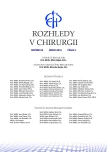Tissue cyanoacrylate glue in partial nephrectomy – our own experience and assessment
Authors:
J. Košina; J. Pacovsky; P. Hušek; L. Holub; M. Broďák
Authors‘ workplace:
Urologická klinika FN a LF Univerzity Karlovy, Hradec Králové
přednosta: doc. MUDr. M. Broďák, Ph. D.
Published in:
Rozhl. Chir., 2016, roč. 95, č. 2, s. 79-82.
Category:
Original articles
Overview
Introduction:
The effect of cyanoacrylate glues was repeatedly evaluated in resections of liver, lungs and others organs, but minimally in kidney resection. The aim of our study was to evaluate the use of cyanoacrylate tissue glue in open and laparoscopic partial nephrectomy.
Method:
We evaluated a cohort of 32 patients who underwent partial nephrectomy with treatment of the resected area using cyanoacrylate glue. Laparoscopic resection was done in 23 patients, while 9 patients underwent an open procedure. Surgical results, complications and oncologic results were assessed.
Results:
The median follow-up duration was 46 months. The mean time of open partial nephrectomy was 104 minutes and that of laparoscopic resection was 154 minutes; blood losses reached 250 ml and 184 ml, respectively. No serious complications occurred, and all patients survived the 3-year follow-up without any tumor recurrence.
Conclusion:
Hemostasis using the cyanoacrylate glue Glubran II was effective and safe. On the other hand, it increased the costs of the surgery and was not necessary.
Key worlds:
partial nephrectomy − laparoscopic resection of kidney − cyanoacrylate tissue glue
Sources
1. Breda A, Stepanian SV, Lam JS, et al. Use of haemostatic agents and glues during laparoscopic partial nephrectomy: a multi-institutional survey from the United States and Europe of 1347 cases. Eur Urol 2007;52 : 798−803.
2. Bektas H, Nadalin S, Szabo I, et al. Hemostatic efficacy of latest-generation fibrin sealant after hepatic resection: a randomized controlled clinical study. Langenbecks Arch Surg 2014;399 : 837−47.
3. Pandanaboyana S, Bell R, Shah N, et al. A cost-effective analysis of fibrin sealants versus no sealant following open right hemihepatectomy for colorectal liver metastases ANZ Journal of Surgery 02/2015; DOI:10.1111/ans.12948.
4. Bochicchio GV, Gupta N, Porte RJ, et al. The FINISH-3 trial: a phase 3, international, randomized, single-blind, controlled trial of topical fibrocaps in intraoperative surgical hemostasis. J Am Coll Surg 2015;220 : 70−81.
5. Alar T, Ceylan KC, Duman E, et al. Is acrylate co-monomer (Glubran-2) useful in the prevention of prolonged air leaks after pulmonary lobectomy? Indian J Surg 2013;75 : 373−6.
6. Paral J, Lochman P, Blazej S, et al. Glued versus stapled anastomosis of the colon: an experimental study to determine comparative resistance to intraluminal pressure. Asian J Surg 2014;37 : 154−61.
7. Epidemiologie zhoubných nádorů v České republice. Dostupný na www: http://www.svod.cz/analyse.php?modul=incmor#
8. Staněk R. Použití tkáňového lepidla při ledvinu šetřící parciální nefrektomii Urol praxi 2010;11 : 335−7.
9. Eisenberg MS, Brandina R, Gill IS. Current status of laparoscopic partial nephrectomy. Curr Opin Urol 2010;20 : 365−70.
10. Hora M, Eret V, Stránský P, et al. Evoluce operační techniky laparoskopické resekce nádorů ledvin. Ces Urol 2010,14 : 24−31.
11. Všetička J. Současné možnosti laparoskopie v urologii Urol praxi 2004;3 : 105−7.
12. Hora M, Eret V, Ürge T, et al. Možnosti využití tkáňových lepidel při ledvinu šetřících výkonech u tumorů ledvin. Ces Urol 2007,11 : 147−53.
13. Lequaglie C, Giudice G, Marasco R, et al. Use of a sealant to prevent prolonged air leaks after lung resection: a prospective randomized study. J Cardiothorac Surg 2012;7 : 106−7.
14. Jiang K, Long YZ, Chen ZJ, et al. Airflow-directed in situ electrospinning of a medical glue of cyanoacrylate for rapid hemostasis in liver resection. Nanoscale 2014;6 : 7792−8.
15. Subrt Z, Ferko A, Cecka F, et al. Oncologic aspects of laparoscopic liver resection. Rozhl Chir 2012;91 : 105−9.
16. Haslinda AR, Azhany Y, Noor-Khairul R, et al. Cyanoacrylate tissue glue for wound repair in early posttrabeculectomy conjunctival bleb leak: a case series. Int Med Case Rep J 2015;8 : 145−50.
17. Durgakeri PU, Kaska M. Post-operative intraperitoneal adhesion prevention−the recent knowledge. Rozhl Chir 2006;85 : 286−9.
18. Johnston WK 3rd, Kelel KM, Hollenbeck BK, et al. Acute integrity of closure for partial nephrectomy: comparison of 7 agents in a hypertensive porcine model. J Urol 2006;175 : 2307−11.
19. Huang SH, Chiu AW, Lin CH, et al. Efficacy of ultrasonic tissue dissector and tissue glue for laparoscopic partial nephrectomy in a porcine model. Int Surg 2003;88 : 199−204.
20. Petrosian AG. Use of a cyanoacrylate glue in the experimental resection of the pole of the kidney. Zh Eksp Klin Med 1975;15 : 24−9.
21. Taffurelli M, Minni F, Grassigli A, et al. Isobutyl-2-cyanoacrylate in resection of the upper pole of the kidney in rats and rabbits: surgical technic and histological followup (author‘s transl). Chir Ital 1980;32 : 233−41.
22. Langer D, Pudil J, Rudiš J, et al. Přínos robotického systému da Vinci v abdominální onkochirurgii – naše předběžné výsledky. Rozhl Chir 2013;92 : 85−90.
23. Zhang X, Yan J, Ren Y, et al. Robot-assisted versus laparoscopic partial nephrectomy for localized renal tumors: a meta-analysis. Int J Clin Exp Med 2014;7 : 4770−9.
24. Selli C, Turri FM, Mariani C, et al. The management of small renal masses: what is likely to change? Urologia. 2015;82 : 193−202.
25. Potretzke AM, Bhayani SB. Laparoscopic partial nephrectomy: rest in peace. Eur Urol 2015;67 : 902−3.
26. Choi JE, You JH, Kim DK, et al. Comparison of perioperative outcomes between robotic and laparoscopic partial nephrectomy: a systematic review and meta-analysis. Eur Urol 2015;67 : 891−901.
Labels
Surgery Orthopaedics Trauma surgeryArticle was published in
Perspectives in Surgery

2016 Issue 2
- Metamizole vs. Tramadol in Postoperative Analgesia
- Current Insights into the Antispasmodic and Analgesic Effects of Metamizole on the Gastrointestinal Tract
- Spasmolytic Effect of Metamizole
- Metamizole in the Treatment of Acute Postoperative Pain
Most read in this issue
- Complications of pancreato-duodenectomy
- Surgical versus non-surgical treatment for 3- and 4-part proximal humerus fractures
- Diagnosis and treatment of billiary ileus
- Total duodenopancreatectomy for renal cell carcinoma metastases – case report
